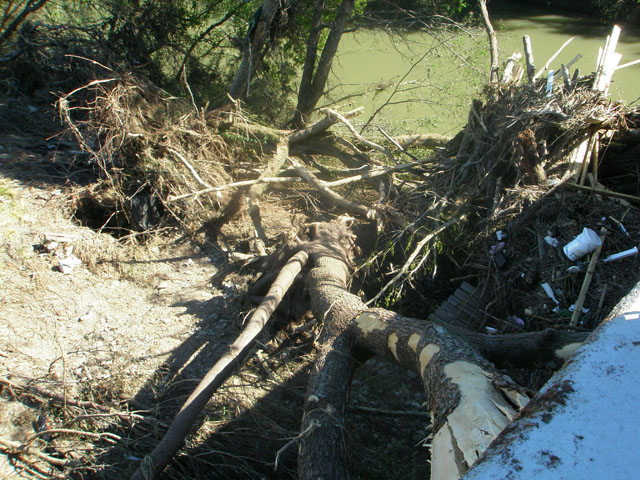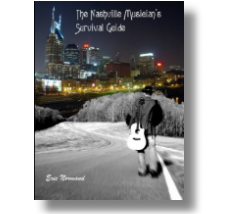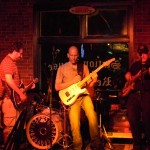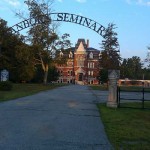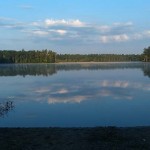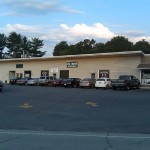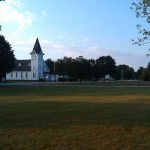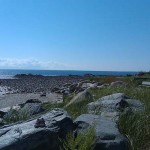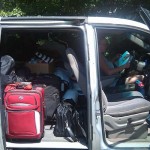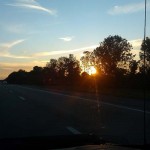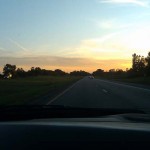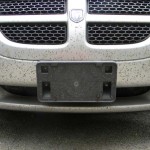
It’s now Saturday morning and we’re in Waukegan, Illinois, just north of Chicago, and back on the Rhett Akins tour. It’s early, I’m the only one up, and the view out the bus window is not unlike many I’ve seen before – a hotel, a highway, and some retail. Several Canadian geese are foraging for their breakfast on a big plane of grass in front of the hotel. I can’t believe that this trip is almost over; it went by at warp speed!
We had been planning our trip to New England since last fall, with my 25th high school reunion tugging at me to return to my homeland 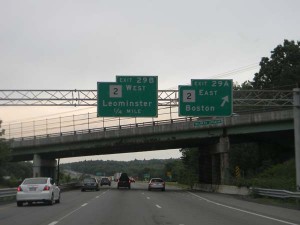 for a brief visit. And even though it ended up turning into a working vacation, with several workshops and book signings taking up much of our time, it ended up being one of the most soul-enriching vacations Kelly and I have ever had. It had been seven years since our last trip home, way too long, and although we had often talked about how much we missed everybody, we didn’t realize just how much until we got there.
for a brief visit. And even though it ended up turning into a working vacation, with several workshops and book signings taking up much of our time, it ended up being one of the most soul-enriching vacations Kelly and I have ever had. It had been seven years since our last trip home, way too long, and although we had often talked about how much we missed everybody, we didn’t realize just how much until we got there.
We set out Monday morning and did the 1240 mile drive over two days, sleeping overnight in a hotel in Pennsylvania. Although the trip was long, our excitement grew as we neared the northeastern states. We spent the first few days of our New England visit in southern Maine, first at Kelly’s sister’s house in Kennebunk, and then at one of our friends homes in Portland. Crammed into the middle of a couple of hectic days centered around music store clinics and a local TV interview, were family reunions, a breakfast with friends, and a wonderful walk on Kennebunk beach on a warm summer day. Some friends hosted a special jam night for me in Dover, NH and it was great to reconnect with old friends there as well.
By the time the weekend rolled around it was time for my high school reunion. It was great to see so many of my old classmates – I can’t believe it’s been 25 years; ‘Father Time’ is so mean! After the reunion we stopped In to Wally’s on Hampton Beach, a club I had played frequently in the late 90s and the place we would be having our reunion show a couple of days later. Living in Tennessee we are a bit landlocked, and we basked in the salty night air of the ocean-side resort town, something we likely took for granted just a few years ago.
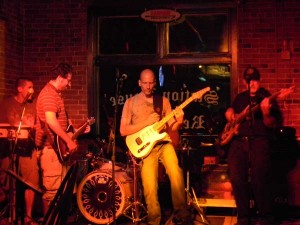 Sunday afternoon would bring another reunion of sorts, this one in the form of a rehearsal in my hometown of Kingston, NH with some old band mates. Members of my old band, Electric Blue, plus one of my former guitar students and one of his friends would comprise the core band for the Wally’s reunion show. We rehearsed in a garage belonging to one of my oldest friends, a place in which I used to rehearse with many of my first bands many years ago. The rehearsal went great and was followed by another family reunion, this one at my parent’s house, the place where I grew up right down the street.
Sunday afternoon would bring another reunion of sorts, this one in the form of a rehearsal in my hometown of Kingston, NH with some old band mates. Members of my old band, Electric Blue, plus one of my former guitar students and one of his friends would comprise the core band for the Wally’s reunion show. We rehearsed in a garage belonging to one of my oldest friends, a place in which I used to rehearse with many of my first bands many years ago. The rehearsal went great and was followed by another family reunion, this one at my parent’s house, the place where I grew up right down the street.
On this night I slept in my old bedroom, it kind of made me feel like a kid again. I woke up real early Monday morning and just lied in bed for a while, reflecting on the amazing journey I have had in the years since I left this place. It was 6 AM, just before sunrise, and the house was quiet, my folks still asleep, and I’m not sure why, but I suddenly had the urge to set out on foot and visit the places of my youth.
I walked out the front door, around the side of our barn, and cut through the neighbor’s yard. I walked past the old cemetery and out onto Main Street, following the beautiful plains past the bandstand, the town hall, the general store, and the library. I came to my old high school “Sanborn Regional”, and just stood there for a moment, transfixed by the memories that came flooding back. I walked through the school grounds, and experienced several moments of déjà vu, remembering different pinpoints in time from decades ago. Coming out of the backside of the high school, I walked down to Greenwood Lake, a place where I used to go fishing as a boy, and parking as a teenager. I walked another mile or so down to Kingston State Park and sat on the shore for a few before visiting the place where Kelly and I got married – a beautiful little spot on the shore of Kingston Lake on the backside of the park. I walked up the trail that comes up behind Clark’s Oil and received a few mosquito bites along the way. Back out onto Main Street, I walked past the old Sadowski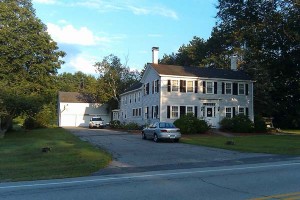 residence, the place where the sounds of Jimi Hendrix blaring out a bedroom window on a warm summer day long ago inspired me to take up the electric guitar.
residence, the place where the sounds of Jimi Hendrix blaring out a bedroom window on a warm summer day long ago inspired me to take up the electric guitar.
After spending a great day with my family I was off to Hampton for another clinic, after which I went to bed early, exhausted as the pace of this trip was starting to catch up with me. We took it easy on Tuesday, trying to have a few still moments to catch our breath at a friend’s house in Hampton. The trip had been great so far, seeing so many friends and family members in such a short period of time, but our heads were literally spinning as a result of the hectic schedule we were keeping. Wednesday morning we managed to squeak in one more walk on a beautiful private beach just north of Hampton Beach, reminiscing about the trip.
We had one last thing to do before this exciting trip would come to an end, and that was the reunion show at Wally’s. This night turned out to be such an exciting, action-packed adventure in and of itself that it deserves its own story, one that I’ll post a little later. But as far as this brief nine-day stay, it was truly awesome! Kelly and I have relished every moment of our Nashville journey, we wouldn’t be who we are today if we had not embarked on it. We have met and become friends with many wonderful people in middle Tennessee, and other parts of the country as well. But reconnecting with our friends and family in New England was an emotional and powerful experience; you all have a special place in our hearts and we miss you already. See y’all next year!
After spending my first 35 years living in New England, getting used to the humid subtropical climate of Nashville took some effort. Compared to middle Tennessee, spring through fall in the Northeast is quite mild, while the dreaded winter months have often been compared to those of Canada or Siberia. Those brutally cold and frigid winters can sometimes begin as early as mid-October and last all the way through April on some years. Snowstorms, ice storms, daily high temperatures in the 20s, teens, or less, and brutal nor’easter’s are often daily occurrences for months on end. And then finally, the snow starts to melt, the birds return, the trees begin to grow leaves again, and spring is upon us. Of course Spring can also be a cold wash out with temperatures only reaching the 50s accompanied by the kind of rainfall that could rival Seattle. On years where this happens, it seems like it goes straight from winter to summer. I used to think, before I 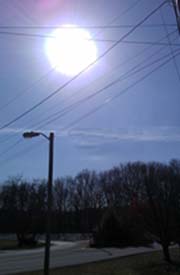 lived in the South, that New England summers could get too hot, but in hindsight I was just being a baby. How I long for those pussified summers now. Fall in New England is arguably the best weather of the year. Cool, dry, great weather to be outdoors.
lived in the South, that New England summers could get too hot, but in hindsight I was just being a baby. How I long for those pussified summers now. Fall in New England is arguably the best weather of the year. Cool, dry, great weather to be outdoors.
That’s all behind me now. For the climate of Nashville, my new home, is radically different, and one that requires a whole new mindset. The winters in Nashville, if you want to call them that, are almost more like spring in New England. While it can get cold, occasionally getting down into the teens or low 20s, it is not uncommon to have several warm sunny days in each of the winter months, temperatures sometimes even climbing into the 70s. It might snow once or twice, maybe an ice storm or two, some rain, but in general I find these winters very livable compared to those of my New England years. Spring can be real nice temperature wise, but this is also our primary tornado season and, after this year, flood season. This brings us to summer, or as I call it, hell on earth. Beginning in June, or sometimes as early as mid-May, it’s 90° plus and humid every day for what seems like an eternity, typically all the way through September. Some get used to this heat and humidity but I can’t stand it, to me this is a New England winter in reverse.
During the cold wet winter months of New England, outdoor activities all but grind to a halt (except of course for those who love to ski or snowmobile). In general, except for commuting to work, most New Englanders stay indoors during this time of year, waiting for it to warm up a bit to resume outdoor activities. Now that I live in Nashville this is how I approach summer. In general, it’s just too hot and humid for me to enjoy the outdoors during this time of year, and I find myself waiting for it to end so I can again enjoy the outdoors on a regular basis. I literally get cabin fever during the summer. But then it finally ends with the onset of fall, my favorite time of year here, by early to mid October. Of course we have to be on our toes in November for our secondary tornado season.
So I don’t know if it’s just me or if other transplants feel this way, but as far as the climate of middle Tennessee goes – Fall is great, Winter is palatable, Spring can be hairy, but Summer just plain sucks. I’m glad it’s finally over.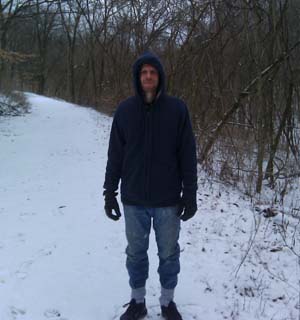
In this day and age, looking the part is often just as important as playing the parts for many professional musicians. This is equally important for those who have not yet achieved a career in music, but are working towards one. While being proficient on your instrument and possessing good social and networking skills are obviously important, in the world of live music performance, your appearance can sometimes be a deciding factor on getting the gig.
It’s easy to find the right clothes, and it’s a well-known fact that working out and having a good physique will make those close “hang well” on your frame. But for some (men especially), the hairstyle, or lack thereof, can be a dealbreaker. I’m not talking about the 20 something’s with the $300 spiky mod looking haircuts. As much as I don’t care for that look, they are not the biggest offenders of the modern day hair wars. In my opinion, it’s the guys who are losing their hair but living in denial that really need to rethink the current state of the top of their heads.
It’s no secret that many of us have lost, are losing, or will lose much our hair over the course of our lives. For some it begins as early as late teens or early 20s, for others it might not happen until they’re in their 30s or 40s, while others manage to hold on to most of their mop 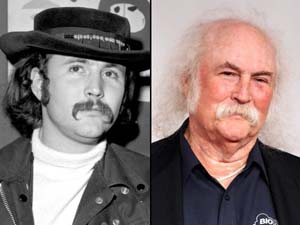 until old age. Sometimes this hair loss happens rapidly, over several months or a couple of years and sometimes it can occur very slowly and gradually over decades. Some just get a little bald patch near the back of our head, while others are stricken with more of that dreaded “parting of the seas” look.
until old age. Sometimes this hair loss happens rapidly, over several months or a couple of years and sometimes it can occur very slowly and gradually over decades. Some just get a little bald patch near the back of our head, while others are stricken with more of that dreaded “parting of the seas” look.
Many musicians take great pride in their hair, often choosing a style that works for them in their younger years and sticking with that as they age. Some will sport short to medium length do’s while others choose to wear it long, anywhere from the mid-60s Beatles look all the way to full-blown hippie length. But if you are in the unlucky category that many of us fall into, that being the permanent hair loss club, these styles will begin to create a different effect and take on new meanings as these  hair follicles slowly begin to vanish forever.
hair follicles slowly begin to vanish forever.
Are you the guy with the comb-over? If you are, you’re not fooling anyone. Maybe you’re the guy that had hair like Greg Allman when you were in your 20s. Oh, how the girls loved it back then. But how are you being perceived now when that part between you’re neatly combed and blowdried shoulder length blond hair rival’s the San Andrea’s fault? Probably more like the friendly lion in the wonderful Wizard of Oz. There’s always a baseball cap. But eventually, as people notice over time that you’re never seen without one, it will become a dead giveaway that you’re hiding something. You could always grow a beard and start wearing a cowboy hat, sporting your version of some kind of half assed Travis Tritt look, but that’s a pretty big commitment, and not that hip anyway. Not to mention, when you commit to the whole hat thing, what happens when you go swimming? What happens the first time you sleep with a new girlfriend?
Face it, none of this works. Yet, somehow, we see people that look like this all the time. Well I have some  great news for all of you who are fighting this futile “battle of the bald”. There is a way out, and I’m not talking about hair transplants, wigs, or toupe’s. Just let it go. That’s right, shave it off. Bald is beautiful, baby. For proof, look no further than Telly Savalas or Bruce Willis.
great news for all of you who are fighting this futile “battle of the bald”. There is a way out, and I’m not talking about hair transplants, wigs, or toupe’s. Just let it go. That’s right, shave it off. Bald is beautiful, baby. For proof, look no further than Telly Savalas or Bruce Willis.
Growing up, I had a thick head of hair, and by the time I was 15 had already experimented with growing it long. I went in and out of short hair and long hair mode for a few years before going all out in the late 80s, when I began sporting a full-blown Richard Marx style mullet. Of course, at that moment in time that style was in, so spending 20 minutes with a can of moose and a blow dryer to get ready to go out for the night, or gig, was completely natural. Of course I kept this “helmet do” well into the 90s, long after it had become unfashionable. Then, in my mid-20s, it all started going quite badly.
Over a period of about a year, I lost most of the hair in the middle of my head. It happened so quickly that I hardly even noticed at first. But then when my girlfriend started telling me that I was beginning to look like Michael Bolton, I knew something was wrong. On a bad day, my massive bouffant do, once reminiscent of Peter Frampton’s early look, began to look more like that of the comedian, Gallagher. Comments like “Here comes Billy Crystal” or “Is that Stephen Wright?” and even “When did David Crosby lose all that weight?” also caused much embarrassment. So I began a slow transformation. I attempted to minimize my baldness by wearing hats, doo-rags, even at times pulling it back into a ponytail. But ultimately, this wasn’t working. Half the time it just looked bad.
So finally, around the year 2000, I took it down to a fairly short length, just an inch or so on top. It was better than having “Gallagher syndrome”, but still not quite right. Shaving it down to the scalp was the only thing left to try. At first, I was horrified at the thought of doing this, but with a little prodding from my wife, I went for it. Boy am I glad I did. I instantly realized that bald works for me. Having a bunch of hair on the sides with the bald spot in the middle was simply drawing attention to the fact that I was balding. Lose all that hair, and you create the perception that you are bald by choice, not because of nature. In other words, nobody can tell that all your  hair fell out. Now when I look in the mirror, I feel younger.
hair fell out. Now when I look in the mirror, I feel younger.
 Plus there are many added benefits. Showers now take five minutes. I save a small fortune on shampoo and conditioner and haven’t bought a comb or a hair brush in decades. Getting ready to go to work or out on the town now only takes seconds. It’s harder to get dandruff, and my head is now essentially “lice-proof”. But most important of all, I no longer look like an idiot.
Plus there are many added benefits. Showers now take five minutes. I save a small fortune on shampoo and conditioner and haven’t bought a comb or a hair brush in decades. Getting ready to go to work or out on the town now only takes seconds. It’s harder to get dandruff, and my head is now essentially “lice-proof”. But most important of all, I no longer look like an idiot.
So which guy are you? Are you still clinging to the past, or have you embraced your inner baldness? Whose look do you relate to more, Stephen Gallagher or Bruce Willis? It’s not too late to save yourself. So what are you waiting for, get out those clippers and get busy!
With each day bringing horrific new insight and ever more uncertainty regarding the oil spill in the Gulf, it’s now more important than ever to become educated and aware about the world we live in. With that in mind, my wife Kelly and I have decided to start our own news blog site, The Normand Post. This forum which will exist to explore the problems facing humanity and all of the planetary systems, and start an open-ended dialogue to help create solutions.
In the meantime, I will continue my efforts to document the Tennessee flood, writing blogs and articles for my own site, and other websites as well.
One recent news story in Nashville, examined the temporary dumping station at Edwin Warner park for the massive amount of storm debris being collected around middle Tennessee. Every day a fleet of trucks makes rounds collecting piles of house debris, appliances, drywall, just about anything you can think of, and bring it to this temporary holding station where it is then trucked off to landfills throughout the state. I decided to take a drive by there today to see it firsthand. The debris is piled as high as the trees, on an area the size of a football field, and is a quite disheartening sight to see alongside some kids playing a game of soccer. Yesterday, when I went to the local dump near my house in Cheatham County, I noticed three large dump trucks dumping there, obviously part of this debris removal. What I found disturbing, was the mile-long trail of dirt leaving the dump in either direction, obviously spill off of what must be a now constant parade of trucks now dumping here from all over. More on that later.
I’ve also uploaded a new slideshow containing most of the flood and aftermath photos I have taken, with captions.
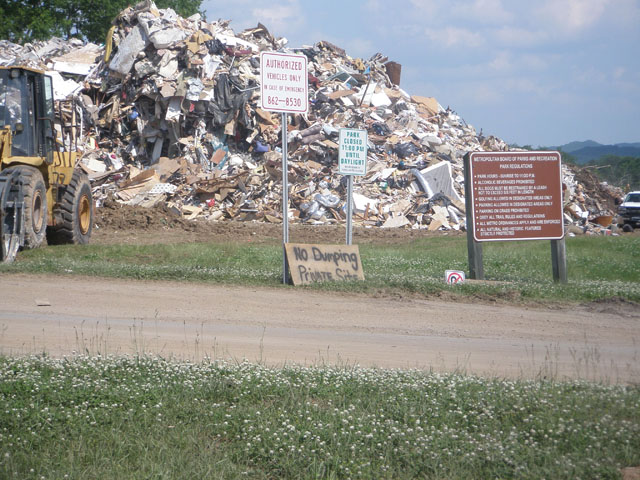
It’s been a busy week, and there have been many new developments I would like to share. On Monday, MSNBC posted an article I wrote about the flood on one of their websites, The Maddow Blog. My new contact at that website is urging me to continue reporting on the disaster, and submitting more articles. In the days since then, I’ve been conducting more research and compiling data for future writings.
I’ve also refocused my efforts toward completing my book. Right now my manuscript for “The Nashville Musicians Survival Guide” is sitting as one massive word document on my computer. As I have been away from the project for about a month, I have decided to turn it into a PDF and print out a couple of unformatted hard copies. I plan to read it cover to cover over the next couple of weeks to better assess where I’m at. I’ll also probably give a copy to a couple of my music industry friends to get some objective opinions. I’m pretty excited to have a copy, even a crude first draft, in my hand.
It’s been a pretty good week for musical activities as well. Earlier in the week I tracked a live drum session in my studio for a songwriter project I’ve been working on. I also spent some time recording guitar tracks and doing some finished mixing of the material. Last night I played with my classic rock and blues band, “The West End Rhythm Kings” at Cancun in Bellevue, and it was tons of fun, some much-needed music for the soul.
There’s also been one other exciting development this week. In my flood research for the Maddow Blog, I came across the website, climateprogress.org. I e-mailed the site’s editor, Dr. Joseph Romm, with some thoughts and questions about the Tennessee flood, as I have been wanting to talk to a climate expert ever since our extreme rain event. The result was some dialogue in which he encouraged me to submit a report on the disaster to post on his site, which just happens to be the biggest climate related website in the world. The article I submitted was a rewrite of one of my blogs from two weeks ago, with updated information, and a link to a photo slideshow that Kelly helped put together. In the coming weeks, I will be conducting more research to submit a series of articles to MSNBC and the Climate Progress website.
Not bad for a guitar player from New Hampshire.
For everyone that lived through the Tennessee flood of 2010, the flood is still here. While the water has receded from most areas, in general, the state is still a mess. Every day I continue to hear new stories about people and families affected by the flood, and some have still not received any help. In the absence of any real national media coverage, I have been making my own attempts to help this disaster gain further attention, and yesterday I may have caught a good break when the Rachel Maddow show on MSNBC put my reporting and pictures on their website.
Last week I submitted some op-ed pieces to the nation’s largest newspapers, and yesterday, I’m not sure if this is a coincidence or not, the Washington Post published an article that draws on some of the points from my letter. I also believe the fact I was able to have some of my writings and pictures posted on the MSNBC website is significant. I have been writing about this disaster since it began, and by steadily chipping away at it, I now have a contact with somebody at MSNBC who wants to help the story gain attention. I plan to continue my efforts to help inform the rest of the world of our plight in the weeks to come, and I urge everyone to do the same. I think it’s extremely important that the message is put forth that the state of Tennessee, not just Nashville, has been devastated by this flood.
Please follow this link to my report on the MSNBC website and leave a comment under it. This will increase the likelihood that Rachel will discuss this disaster on one of her upcoming shows.
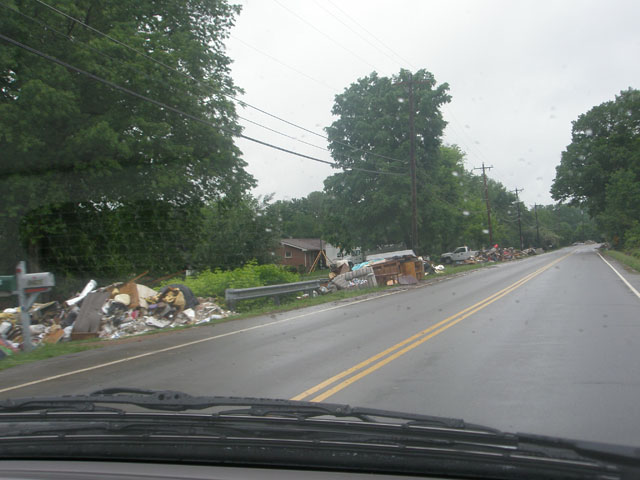
This photo was taken on May 18th on Highway 70 in Bellevue, Tennessee.
If you’ve been following my blog over the past week and a half, I’m sure you’re aware of what’s happened here in Tennessee. While I consider myself extremely lucky to not have lost anything in this flood, the experience of it all has, nevertheless, been exhausting. Being trapped in our home without power for three days, seeing the raging waters come within a half-mile of my home, watching the totality of this horrifying event on the local news in the days afterwards, and then observing the devastation in my community firsthand. And I have it easy. Some of my friends have lost all their musical equipment that was being stored at the Soundcheck rehearsal facility. For others across the state of Tennessee, losses go well beyond musical equipment.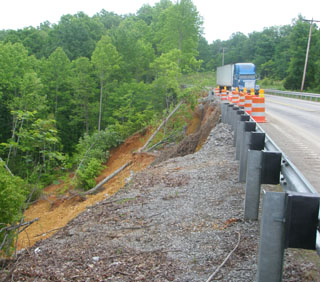
Even though my family, home, or possessions are intact, being on the cusp of a disaster of this magnitude will inevitably change a person in some ways. We had several days of sunshine, thankfully, in the days immediately after the rain stopped. But then, rain was forecast for the weekend. Even though it was only predicted to be an inch or so, the thought of any rain at all, is now disturbing. I have awoken a few times in the middle of the night to visions of the brown murky floodwaters. You can’t drive very far in middle Tennessee without seeing flood damaged buildings, roads, and other ominous reminders. It’s been difficult to focus on many daily routines and tasks, but I am fighting my way back, and it is slowly getting better.
The main goal of this blog, initially, was to focus on the music business and other music related topics, as I am a musician by trade. But it’s been a battle to get my mind out of the storm, back to the business of music, and back to my nearly completed book project “The Nashville Musician’s Survival Guide”. It now seems so ironic that my book is about what it takes for a musician to survive the music business of Nashville, and now Nashville itself is faced with a plight for its own survival.
I will say that writing this blog over the past week and a half has been therapeutic for me. Kind of my own rebuilding process. I’m still thoroughly disappointed in the national media, and feel like we’ve been robbed. First we were raped and pillaged by the storm itself, and then to add insult to injury, ignored by the national media, as if our dire situation was insignificant. In the absence of a media based on real, Edward R. Murrow style journalism, I think it is now extremely important for all concerned citizens to help spread pertinent news stories that aren’t getting told. I have submitted my article “We Are Tennessee; Surviving the Flood of 2010” to several local and national print publications in an attempt for this story to gain further attention. And I will continue to write a few more blogs about our situation, as the struggle for Tennessee to rebuild will go on long after this story fades from the news.
In the days and weeks to come, I will also be working towards getting my head back into music, as well as tackling the seemingly impossible task of completing a book that is 95% done (it feels like the last 5% will drag on longer than the health care debate did). I will finish this book, as I feel compelled to do so, and know it will help many musicians. Of course, I will now have to add one more chapter about flood survival. In the meantime, I will continue working on getting back to normal.
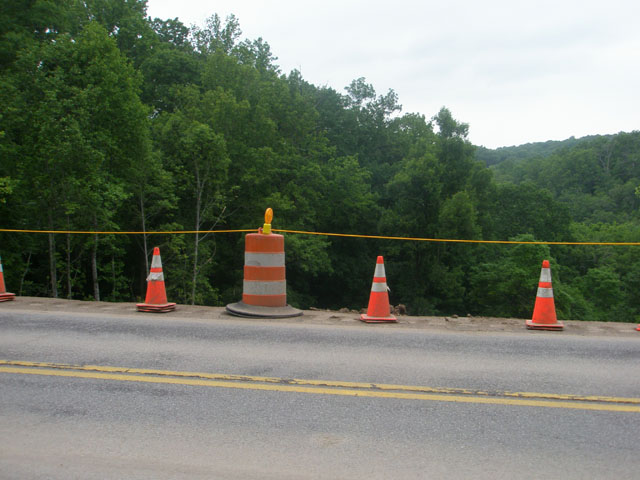
The news of this disaster is getting out there. Volunteers are arriving from all over the country to help rebuild our communities, and we are truly grateful for this outpouring of goodwill. To help rally more support for the relief effort, I have rewritten my blog from last Wednesday, “We Are Tennessee”. This version paints a more total picture of the flood event and how the emergency response and recovery efforts have been handled so far. I realize it’s a bit long for a blog, but it’s a big story. Please help continue to spread the word. Peace
The rain began falling on the morning of Saturday, May 1st, 2010, and by the time it finished, just under 48 hours later; it had dumped between 12 and 20 inches across Middle and Western Tennessee, rendering 52 of Tennessee’s 95 counties disaster areas. Rivers that normally spanned 100 feet across swelled to widths of a half-mile or more, flooding cities, towns, and roadways, washing away homes and bridges, destroying businesses and infrastructure, and leaving thousands homeless. People died in their cars while trapped on flooding interstates and thousands more were stranded in remote communities without power or communication for days. Water plants were decimated, the Grand Ole’ Opry and many other historic buildings and  icons damaged or destroyed, and more than $1 billion of damage had been sustained in Nashville alone. And where was our national media in all of this?
icons damaged or destroyed, and more than $1 billion of damage had been sustained in Nashville alone. And where was our national media in all of this?
It’s now more than a week after this catastrophe began, and I’m still having a hard time grasping the totality of what has happened here. Each new conversation with family members and friends back in my native New England leaves me dumbfounded as to how little they’ve heard about this epic 1000-year flood, many first hearing about it from my phone calls and e-mails. Even a friend that I spoke with in eastern Tennessee was completely unaware that the western half of the state had just experienced what is likely to be the costliest non-hurricane water related disaster in American history. During the flood, and in the days that followed, mainstream news stations like CNN, MSNBC, and Fox, provided minimal coverage of this disaster, dwarfed by the Gulf oil spill, and the New York City car bomber. While those stories are certainly important, an event of this magnitude surely warrants more than just a sentence or two in the national spotlight.
Maybe there’s another reason the media paid so little attention, that being the efficient manner in which this disaster was handled. This disaster, which caused evacuations, power outages, and gridlock all over the state, was not accompanied by looting or other kinds of chaos that might otherwise have drawn the media in. The storm came quickly and without warning, decimating communities and infrastructure statewide, and all levels of government combined with an army of volunteers quickly began to mobilize.
“The President was on the phone to me before the sun came up practically on Monday morning” stated Governor Bredesen. “Slightly after it came up, other people from the White House had called and checked in. I’m very, very pleased with the response we’ve gotten from the administration.” he continued. FEMA administrator Craig Fugate, along with Bredesen and Nashville Mayor Karl Dean, toured flooded areas later in the day. By Tuesday several counties had been declared federal disaster areas, which began to allocate necessary funding for the relief effort. Approximately 80 members of the Tennessee National Guard, manning 19 light to medium tactical vehicles engaged in water rescues and evacuations. The Red Cross was here helping organize relief efforts early on as well. Citizens interacted with local media to help present 24 hour news coverage during the event, as local Nashville and Memphis television stations received 40,000 photos and videos from viewers in the first 48 hours.
it came up, other people from the White House had called and checked in. I’m very, very pleased with the response we’ve gotten from the administration.” he continued. FEMA administrator Craig Fugate, along with Bredesen and Nashville Mayor Karl Dean, toured flooded areas later in the day. By Tuesday several counties had been declared federal disaster areas, which began to allocate necessary funding for the relief effort. Approximately 80 members of the Tennessee National Guard, manning 19 light to medium tactical vehicles engaged in water rescues and evacuations. The Red Cross was here helping organize relief efforts early on as well. Citizens interacted with local media to help present 24 hour news coverage during the event, as local Nashville and Memphis television stations received 40,000 photos and videos from viewers in the first 48 hours.
In the center of this immediate and massive effort were the people of Tennessee, with thousands of volunteers engaging from the onset, working as one unified collective with the various government agencies. From the very beginning of this disaster, a spirit of goodwill was evident.
One of my neighbors informed me that on Sunday, day two of the flood, the Publix in Bellevue used generator power to open the store, despite the electricity being down in that area. In 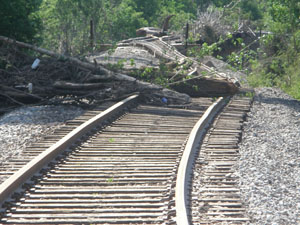 addition to making food, water, and ice available, they also set up a long line of tables on which power strips were placed for local residents to charge cell phones. During the flood event, thousands of volunteers responded to different newscast announcements, showing up at multiple locations to help fill sandbags, assist with boat rescues, as well as a variety of other relief efforts. Community centers and churches across the state became havens for families who lost homes. Schools became water distribution centers. A local construction company owner who was being interviewed on the news said that he already began fixing the roads in his area, as the county road crews were overwhelmed. When officials announced the need to conserve water, water usage almost immediately decreased.
addition to making food, water, and ice available, they also set up a long line of tables on which power strips were placed for local residents to charge cell phones. During the flood event, thousands of volunteers responded to different newscast announcements, showing up at multiple locations to help fill sandbags, assist with boat rescues, as well as a variety of other relief efforts. Community centers and churches across the state became havens for families who lost homes. Schools became water distribution centers. A local construction company owner who was being interviewed on the news said that he already began fixing the roads in his area, as the county road crews were overwhelmed. When officials announced the need to conserve water, water usage almost immediately decreased.
Wednesday, just four days after the flood began, marked the beginning of a three-day flood relief telethon in which many volunteers, including Titans head coach Jeff Fisher and several country music stars, came together to man the phones and help raise money for flood relief. Taylor Swift donated $500,000, with Vince Gill and several others making large donations as well. Benefit concerts are being announced daily. Nashville Mayor Dean announced that the demand for volunteers was going to steadily increase in the weeks and months to 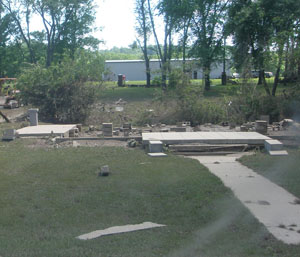 come, and people are responding.
come, and people are responding.
This tragic event of epic proportions is the worst disaster to hit the state of Tennessee since the Civil War, yet our communities are working together. Under the exemplary leadership of Governor Bredesen, combined with the full cooperation of a wide range of local, state, and federal government agencies, the people, the ordinary citizens of this great state are having a huge impact. Neighbors are helping neighbors, people are donating and volunteering, and this event has helped create a sense of unity that is truly magical.
We are not begging the world for help, but to rebuild the communities across this state now shattered by this catastrophe, further assistance will be necessary. Thousands of the homes that were damaged or destroyed were in areas not in flood zones, leaving many homeowners with mortgages on homes that no longer exist, and without insurance money to rebuild. The same is true for many business owners as well. Many schools, hospitals, nursing homes, water treatment facilities, roads, bridges, rail systems, and other infrastructure 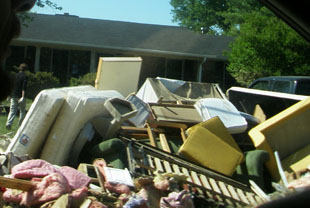 have been damaged or destroyed over an area that spans thousands of square miles. This kind of damage can’t be repaired with just volunteer organizations alone, it’s going to cost billions of dollars and the money has to come from somewhere. In addition to losing their homes and all their possessions, thousands of Tennesseans have also lost their jobs and livelihoods, and this will inevitably put further strain on already stressed entitlement programs. This event has affected over half the counties in the state of Tennessee, not just the city of Nashville as the national media has implied, and it is this message that should be put forth.
have been damaged or destroyed over an area that spans thousands of square miles. This kind of damage can’t be repaired with just volunteer organizations alone, it’s going to cost billions of dollars and the money has to come from somewhere. In addition to losing their homes and all their possessions, thousands of Tennesseans have also lost their jobs and livelihoods, and this will inevitably put further strain on already stressed entitlement programs. This event has affected over half the counties in the state of Tennessee, not just the city of Nashville as the national media has implied, and it is this message that should be put forth.
Perhaps some good can come out of this catastrophe. This disaster has not just brought us closer together as a community, it stands to be a model of how our government can, and should work. A reminder of why government exists in the first place. With so many mounting problems in America today, it is encouraging that our leaders acted so quickly in this moment of despair, and the spirit of community and compassion this event has ignited should be a reminder of all that is good about America, and what we can do when we put our minds together.
So while the people of Tennessee are rebuilding, most of the nation has yet to learn of our predicament and it is unlikely that most will ever know the full extent of what has happened. We will 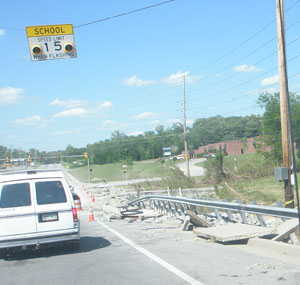 survive, rebuild, and emerge from this wreckage, but as this news has been slow to reach the masses, I urge you all to help spread the word. Natural disasters on this level affect everybody as we are all interconnected. After Katrina, thousands of hurricane refugees relocated to neighboring states, Tennessee among them, and this flood event will inevitably have its own unique set of social and economic impacts that will be far-reaching as well. For many that lived through it, it’s possibly the single most important event of our lifetimes, its significance monumental. In the difficult weeks and months ahead, the people of Tennessee will continue to live, work, and reach out to those in need, because we are all in this together. We are Tennessee, and we are America.
survive, rebuild, and emerge from this wreckage, but as this news has been slow to reach the masses, I urge you all to help spread the word. Natural disasters on this level affect everybody as we are all interconnected. After Katrina, thousands of hurricane refugees relocated to neighboring states, Tennessee among them, and this flood event will inevitably have its own unique set of social and economic impacts that will be far-reaching as well. For many that lived through it, it’s possibly the single most important event of our lifetimes, its significance monumental. In the difficult weeks and months ahead, the people of Tennessee will continue to live, work, and reach out to those in need, because we are all in this together. We are Tennessee, and we are America.
If you need flood relief assistance or would like to volunteer or make donations, please visit the following websites:
Tennessee Emergency Management – www.tnema.org
Middle Tennessee Red Cross Chapters – www.nashvilleredcross.org
Hands on Nashville – www.hon.org
You can also dial 211 for volunteer opportunities if you live in Middle Tennessee
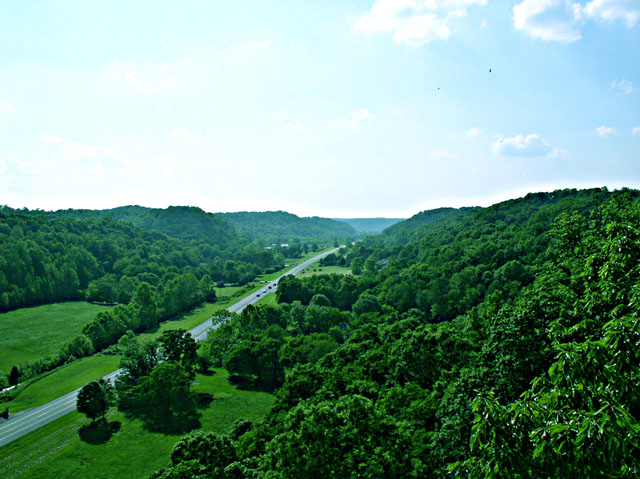
Yesterday, my wife and I took a drive to Percy Warner Park, one of our favorite spots in middle Tennessee. The Warner Parks are over 3000 acres of exceptionally maintained nature reserves, with a nature center, miles of hiking trails, playgrounds, and picnic areas. Unfortunately, neither the Percy Warner Park nor the adjacent Edwin Warner Park escaped the wrath of 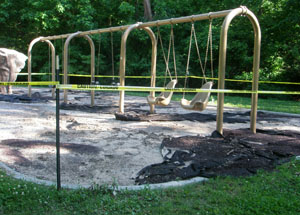 this terrible flood.
this terrible flood.
As we drove into the Highway 100 entrance, the first thing we noticed was the road to the main parking lot was blocked. We were encouraged to see 20 or so cars parked alongside the entrance road, and several families picnicking in the immediate area, attempting to return to some kind of normalcy after such a horrific week. Upon walking past the barrier and down the main entrance road, we noticed caution tape around the playground which had been damaged by the waters. A little further down the paved road, we came to the open sided shed at the beginning of the trailhead, upon which a sign had been placed notifying us that the hiking trails are now closed due to dangerous conditions. A few feet beyond the shed we could see large sections of trail washed away leaving a twisted maze of root structures now  exposed. A little ways up one of the paved roads we saw damaged trees, a few random piles of sticks and twigs, and gullys carved by rushing water along the sides of the road.
exposed. A little ways up one of the paved roads we saw damaged trees, a few random piles of sticks and twigs, and gullys carved by rushing water along the sides of the road.
We couldn’t help but feel a little bit selfish in our newfound sadness. As so many families and individuals lost homes, businesses, and even loved ones, our thoughts of remorse over damaged hiking trails and playgrounds seems insignificant. But the Percy Warner Parks, like many parks throughout the state, represent a certain faction of daily life for many in middle Tennessee, and their preservation is a part of our heritage, so it was still painful to see the destruction. I know the parks will be fixed in time, but I’m sure their priority is lower, understandably, than the dire need to rebuild lives, homes, businesses, infrastructure, and communities across the state.
On a brighter note, the Steeplechase was held in the equestrian center area of the park this past Saturday, and thousands turned out for this annual event. While some have criticized the event for still moving forward, stating people shouldn’t be out having fun 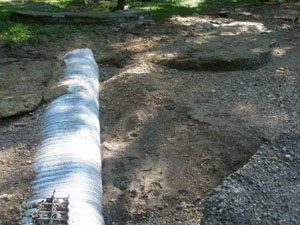 when so much cleanup is still needed, these critics were obviously unaware that the proceeds of this years steeplechase were being donated to relief efforts. It also helped many to begin to feel a little normal again.
when so much cleanup is still needed, these critics were obviously unaware that the proceeds of this years steeplechase were being donated to relief efforts. It also helped many to begin to feel a little normal again.
The funny thing is, that the park, in reality, is fine. The trees are still growing, the streams are still flowing, and the birds are still singing, and they will continue doing so. It is our access that has been cut off. In the meantime, there are still some areas of the park that can be enjoyed, and I suppose we should at least be thankful for that. It was still a sad day at the park.
To see some more photos of park damage, follow this link to where another Tennessean has posted a photo journal of what he saw shortly after the flood.
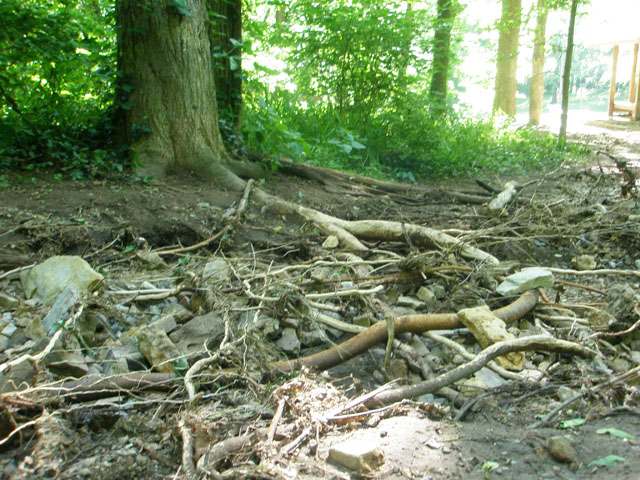
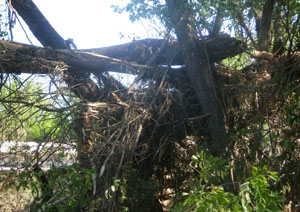 It’s now Sunday, eight days into this new world of a waterlogged state of Tennessee. And although the Gulf oil spill is still the lead story in the national media, about to decimate ecosystems and local fishing industries across the Gulf, I just read an article that suggested the floodwaters in Tennessee could impact the Gulf fishing industry as well. Local fishermen in Gulf communities are fearing that as the floodwaters from the Cumberland River empty into the Mississippi River, the inherent rushing waters will push a large portion of fish into the oil. So far, most of my writings about this disaster, as well as the writings of others, has been about the effect that this flood has had on the people of Tennessee including the loss of life, the destruction of homes, businesses, and infrastructure. But what kind of effect will the flood have on nature, ecosystems, wildlife, and the environment at large? Only time will tell.
It’s now Sunday, eight days into this new world of a waterlogged state of Tennessee. And although the Gulf oil spill is still the lead story in the national media, about to decimate ecosystems and local fishing industries across the Gulf, I just read an article that suggested the floodwaters in Tennessee could impact the Gulf fishing industry as well. Local fishermen in Gulf communities are fearing that as the floodwaters from the Cumberland River empty into the Mississippi River, the inherent rushing waters will push a large portion of fish into the oil. So far, most of my writings about this disaster, as well as the writings of others, has been about the effect that this flood has had on the people of Tennessee including the loss of life, the destruction of homes, businesses, and infrastructure. But what kind of effect will the flood have on nature, ecosystems, wildlife, and the environment at large? Only time will tell. 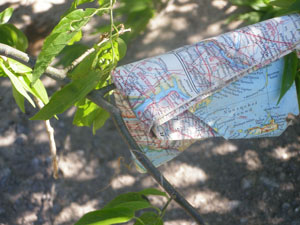
In the meantime, we will continue cleaning up, rebuilding, and moving ahead. I urge you all to help continue spreading the news of this disaster, as the minimal national media coverage we have received, will likely fade in the weeks to come.
If you would like to learn more about what is happening here, there are a series of well written articles that can be found at www.huffingtonpost.com/tag/tennessee-flooding. A telling photo journal can be viewed at www.boston.com/bigpicture/2010/05/flooding_in_tennessee.html. And the following YouTube video also sends a strong message www.youtube.com/watch?v=pFjaQoOdJvI
